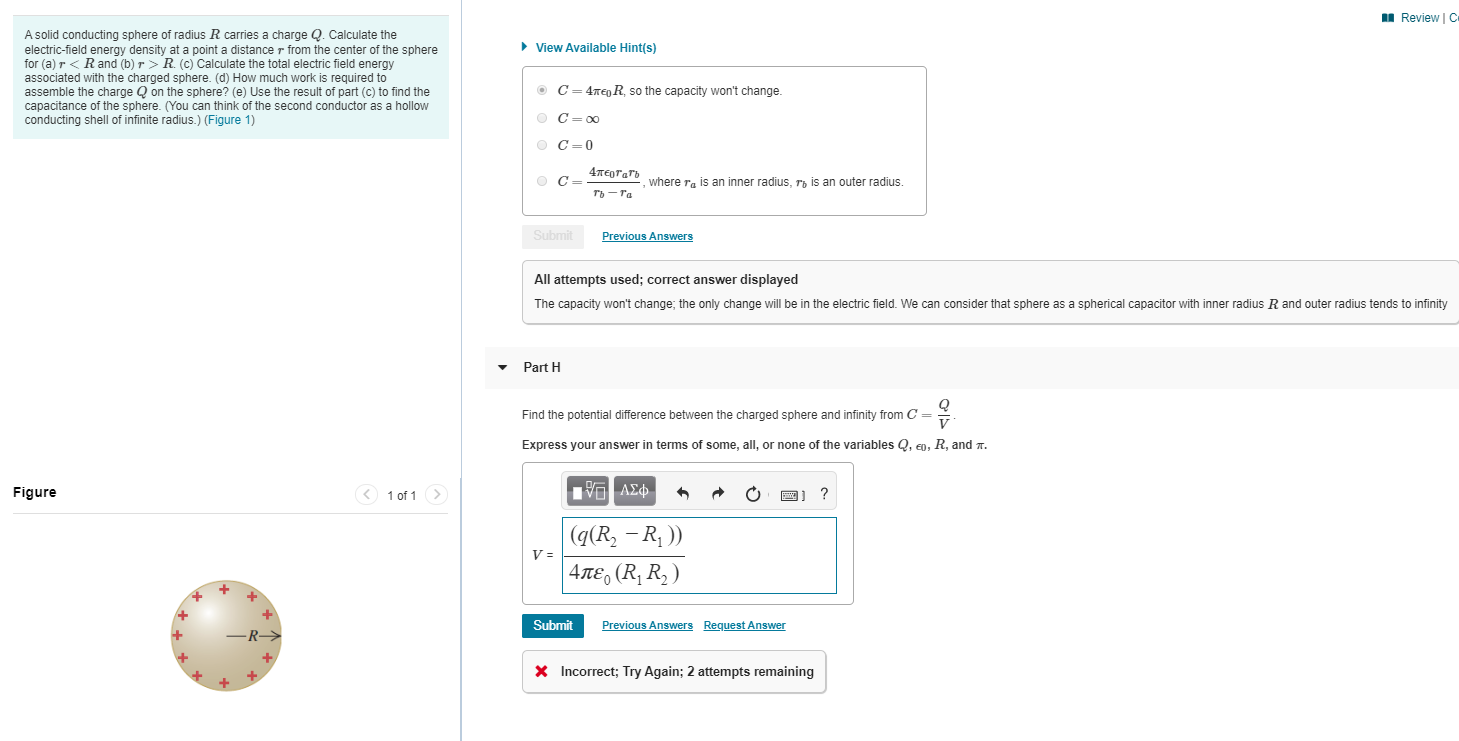
College Physics
11th Edition
ISBN: 9781305952300
Author: Raymond A. Serway, Chris Vuille
Publisher: Cengage Learning
expand_more
expand_more
format_list_bulleted
Concept explainers
Question
thumb_up100%
Just part H

Transcribed Image Text:I Review | C
A solid conducting sphere of radius R carries a charge Q. Calculate the
electric-field energy density at a point a distance r from the center of the sphere
for (a) r < Rand (b) r> R. (c) Calculate the total electric field energy
associated with the charged sphere. (d) How much work is required to
assemble the charge Q on the sphere? (e) Use the result of part (c) to find the
capacitance of the sphere. (You can think of the second conductor as a hollow
conducting shell of infinite radius.) (Figure 1)
• View Available Hint(s)
O C= 4rEnR, so the capacity won't change.
O C= 00
O C=0
4тертать
where ra is an inner radius, rp is an outer radius.
ть — га
Submit
Previous Answers
All attempts used; correct answer displayed
The capacity won't change; the only change will be in the electric field. We can consider that sphere as a spherical capacitor with inner radius R and outer radius tends to infinity
Part H
Find the potential difference between the charged sphere and infinity from C =
Express your answer in terms of some, all, or none of the variables Q, en, R, and n.
Figure
1 of 1 >
ΗVΑΣ
|(g(R - R, ))
| 4πε, (R R, )
Submit
Previous Answers Request Answer
X Incorrect; Try Again; 2 attempts remaining
Expert Solution
This question has been solved!
Explore an expertly crafted, step-by-step solution for a thorough understanding of key concepts.
This is a popular solution
Trending nowThis is a popular solution!
Step by stepSolved in 2 steps with 2 images

Knowledge Booster
Learn more about
Need a deep-dive on the concept behind this application? Look no further. Learn more about this topic, physics and related others by exploring similar questions and additional content below.Similar questions
- Must solve the question completely. Don't solve partially. Skip it pls if u don't want to solve it completely. You must solve the complete question all 6 parts. Otherwise you can skip and let others solve it. But don't solve it partially one or three questions. If you do it, I will dislike for sure.arrow_forwardhat number w.ww The word "units" refers to the corresponding quantity of something. For example, 2 is a number; 2 seconds is a physical quantity that has the units of second. In physics problems, are usually not looking for a number; we are looking for a need to also know the units. If you do not include units with the answer, you will not receive physical quantity, which means we full credit. Physicists are very nitpicky about this! 8. You may have learned the formula distance speed x time. How long would it take in seconds to travel a distance of 2000 meters if you are traveling at a speed of 25 meters per second? (note: your answer must include the word "seconds" or the abbreviation "s" after your number...remember your units! \Sxt t1475 2000 25tt 2000 -25t 1975-t 9. How long would it take in minutes to travel a distance of 2000 meters if you are traveling at a speed of 50 meters per second? S X t e1950 2o00 Sot 2000-50-t 1950 10. How far does sound travel in 1 minute? Put your…arrow_forwarda. 0.400 m/s2b. 0.555 m/s2c. 0.308 m/s2d. 0.385 m/s2arrow_forward
- You slam on the gas of your racecar and you accelerate at 12 m/s² from rest. How long will it take you to reach a velocity of 48 m/s? a. 4 seconds. b. 2 seconds. c. 1 second. d. 12 seconds.arrow_forwardHi I am currently struggling with Extra 1 and Extra 2arrow_forwardI cant get it right, both answers below are incorrect. I need(a) and (b).arrow_forward
- 1. List down three factors that would affect the human reaction time in general. 2. Explain how your reaction time would change if this experiment was conducted on the moon. 3. Explain how your reaction time would change if the mass of the ruler was doubled.arrow_forwardHello, I just need help with part A thank you very mucharrow_forward3. Convert the following values a. I degree to rad and to grad b. 400 grad to rad c. x/2 to grad and to timearrow_forward
arrow_back_ios
SEE MORE QUESTIONS
arrow_forward_ios
Recommended textbooks for you
 College PhysicsPhysicsISBN:9781305952300Author:Raymond A. Serway, Chris VuillePublisher:Cengage Learning
College PhysicsPhysicsISBN:9781305952300Author:Raymond A. Serway, Chris VuillePublisher:Cengage Learning University Physics (14th Edition)PhysicsISBN:9780133969290Author:Hugh D. Young, Roger A. FreedmanPublisher:PEARSON
University Physics (14th Edition)PhysicsISBN:9780133969290Author:Hugh D. Young, Roger A. FreedmanPublisher:PEARSON Introduction To Quantum MechanicsPhysicsISBN:9781107189638Author:Griffiths, David J., Schroeter, Darrell F.Publisher:Cambridge University Press
Introduction To Quantum MechanicsPhysicsISBN:9781107189638Author:Griffiths, David J., Schroeter, Darrell F.Publisher:Cambridge University Press Physics for Scientists and EngineersPhysicsISBN:9781337553278Author:Raymond A. Serway, John W. JewettPublisher:Cengage Learning
Physics for Scientists and EngineersPhysicsISBN:9781337553278Author:Raymond A. Serway, John W. JewettPublisher:Cengage Learning Lecture- Tutorials for Introductory AstronomyPhysicsISBN:9780321820464Author:Edward E. Prather, Tim P. Slater, Jeff P. Adams, Gina BrissendenPublisher:Addison-Wesley
Lecture- Tutorials for Introductory AstronomyPhysicsISBN:9780321820464Author:Edward E. Prather, Tim P. Slater, Jeff P. Adams, Gina BrissendenPublisher:Addison-Wesley College Physics: A Strategic Approach (4th Editio...PhysicsISBN:9780134609034Author:Randall D. Knight (Professor Emeritus), Brian Jones, Stuart FieldPublisher:PEARSON
College Physics: A Strategic Approach (4th Editio...PhysicsISBN:9780134609034Author:Randall D. Knight (Professor Emeritus), Brian Jones, Stuart FieldPublisher:PEARSON

College Physics
Physics
ISBN:9781305952300
Author:Raymond A. Serway, Chris Vuille
Publisher:Cengage Learning

University Physics (14th Edition)
Physics
ISBN:9780133969290
Author:Hugh D. Young, Roger A. Freedman
Publisher:PEARSON

Introduction To Quantum Mechanics
Physics
ISBN:9781107189638
Author:Griffiths, David J., Schroeter, Darrell F.
Publisher:Cambridge University Press

Physics for Scientists and Engineers
Physics
ISBN:9781337553278
Author:Raymond A. Serway, John W. Jewett
Publisher:Cengage Learning

Lecture- Tutorials for Introductory Astronomy
Physics
ISBN:9780321820464
Author:Edward E. Prather, Tim P. Slater, Jeff P. Adams, Gina Brissenden
Publisher:Addison-Wesley

College Physics: A Strategic Approach (4th Editio...
Physics
ISBN:9780134609034
Author:Randall D. Knight (Professor Emeritus), Brian Jones, Stuart Field
Publisher:PEARSON